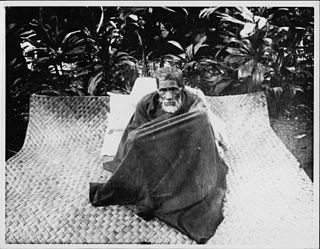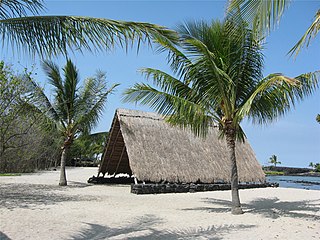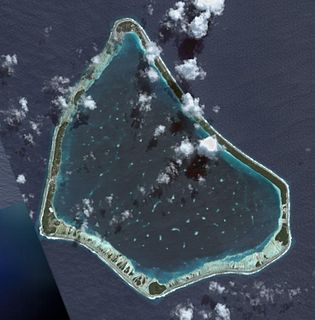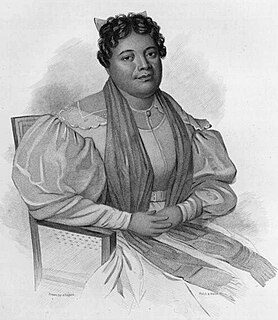Related Research Articles

Kāhuna is a Hawaiian word, defined as a respected person who has moral authority in society; a "priest, sorcerer, magician, wizard, minister, expert in any profession ".

In Māori mythology, Matuku-tangotango (Matuku) is an ogre who kills Wahieroa the son of Tāwhaki. In some versions, Matuku lives in a cave called Putawarenuku. Rātā, the son of Wahieroa, sets off to avenge his murdered father, and arrives at last at Matuku's village. He hears from Matuku's servant that at the new moon his master can be killed at the pool where he washes his face and hair. When the new moon has come, Rātā waits until the ogre comes out of his cave and is leaning over with his head in the pool. He grabs him by the hair and kills him. Rātā then sets off to rescue his father's bones from the Ponaturi. A South Island version names the islands where Matuku lives as Puorunuku and Puororangi and also states that Rātā nooses Matuku as he comes out of his lair to perform certain rituals.

Kuini Liliha was a High Chiefess (aliʻi) and noblewoman who served the Kingdom of Hawaii as royal governor of Oʻahu island. She administered the island from 1829 to 1831 following the death of her husband Boki.

The Makahiki season is the ancient Hawaiian New Year festival, in honor of the god Lono of the Hawaiian religion.

Kealakekua Bay is located on the Kona coast of the island of Hawaiʻi about 12 miles (19 km) south of Kailua-Kona. Settled over a thousand years ago, the surrounding area contains many archeological and historical sites such as religious temples (heiaus) and also includes the spot where the first documented European to reach the Hawaiian islands, Captain James Cook, was killed. It was listed in the National Register of Historic Places listings on the island of Hawaii in 1973 as the Kealakekua Bay Historical District. The bay is a marine life conservation district, a popular destination for kayaking, scuba diving, and snorkeling.

Kaloko-Honokōhau National Historical Park is a United States National Historical Park located in the Kona District on the Big island of Hawaiʻi in the U.S. state of Hawaiʻi. It includes the National Historic Landmarked archaeological site known as the Honokōhau Settlement. The park was established on November 10, 1978, for the preservation, protection and interpretation of traditional native Hawaiian activities and culture.

Manihiki is an island in the northern group of the Cook Islands known informally as the "Island of Pearls". It is approximately 1,299 kilometres (807 mi) north of the capital island of Rarotonga, making it one of the most remote inhabitations in the Pacific Ocean. Its name has two possible meanings: It's believed that the original name of the island was Manuhiki, inspired by the aboriginal discovers Manu coming from the word Rua Manu and Hiki meaning ashore, so the literal translation would be canoe carried ashore. The second interpretation is that the original discoverers were from Manihi, an island in Tuamotus, so the name of the island would mean Little Manihi.

Feather cloaks have been used by several cultures.

Miriam Auhea Kalani Kui Kawakiu o Kekāuluohi Kealiʻiuhiwaihanau o Kalani Makahonua Ahilapalapa Kai Wikapu o Kaleilei a Kalakua also known as Kaʻahumanu III, was Kuhina Nui of the Kingdom of Hawaii, a queen consort of both King Kamehameha I and Kamehameha II, and mother of another king. In Hawaiian, her name Kekāuluohi means the vine growing with shoots. She adopted her secondary name Auhea, meaning Where, oh where, in memory of the death of Kamehameha I.

In Māori mythology, accounts vary somewhat as to the ancestry of Rātā. Usually he is a grandson of Tāwhaki and son of Wahieroa. Wahieroa is treacherously killed by Matuku-tangotango, an ogre. Rātā sets out to avenge the murder, travelling to the home of Matuku, where a servant of the ogre tells him that Matuku comes out to devour people each new moon, and that he can be killed at the pool where he washes his face and hair. Rātā waits till the ogre comes out and is leaning over with his head in the pool. He grabs him by the hair and kills him. Matuku's bones are used to make spears for hunting birds.
In the Tuamotu islands, the telling of the full cycle of the legend of Rata takes several evenings to tell.
Rata, in Tahitian mythology, is said to have become king of Tahiti when his uncle, king Tumu-nui, and his father Vahieroa are swallowed by a great clam while they are on their way to Pitcairn. When he reaches adulthood, Rata plans to avenge his father. As in the Tuamotuan version, Rata identifies a tree to build his canoe, but it is protected by forest elves. After he captures them they build it for him in a single night. While en route for Pitcairn, Rata and his crew are sucked down into the same clam, but they use their spears to cut the monster open. They rescue the remains of Rata's father and uncle and bury them back in Tahiti. After recovering from their adventure, Rata sets out for further adventures. See also Aremata-Popoa and Aremata-Rorua.

Māori mythology and Māori traditions are two major categories into which the remote oral history of New Zealand's Māori may be divided. Māori myths concern 'out of this world' tales relating to the origins of what was the observable world for the pre-European Māori, often involving gods and demigods. Māori tradition concerns more folkloric legends often involving historical or semi-historical forebears. Both categories merge in whakapapa to explain the overall origin of the Māori and their connections to the world which they lived in.
The Coffin family were a group of whalers operating out of Nantucket, Massachusetts, from the seventeenth to the nineteenth centuries. Some members of the family gained wider exposure due to their discovery of various islands in the Pacific Ocean.
The Aliʻi nui of Maui was the supreme ruler of the island of Maui, one of the four main Hawaiian Islands. The title is the same as that of the Aliʻi nui of the other islands. The title or phrase Mōʻī is sometimes used for the title of the monarchs of Maui; however, it is not an ancient word in the Hawaiian language and has origins in the mid 19th century. The only monarchs to officially hold the title of Mōʻī are Kalākaua and his sister Liliuokalani.
Kamanawa II known as Kamanawa ʻŌpio or Kamanawa ʻElua was a Hawaiian high chief and grandfather of the last two ruling monarchs of the Kingdom of Hawaii, King David Kalākaua and Queen Lydia Makaeha Liliʻuokalani. His family had a good reputation until 1840, when he was convicted of murdering his wife.

Hoʻolulu (1794–1844) was a member of the nobility during the formation of the Kingdom of Hawaii. He was a trusted advisor to King Kamehameha I, also known as "Kamehameha the Great", and was one of the select few to know his secret resting place. His descendants continue the tradition of guarding royal burials. A major cultural site in Hilo, Hawaii is named after him.
Kepoʻokalani was a High Chief during the founding of the Kingdom of Hawaii. Two of his grandchildren would marry each other, and two of his great-grandchildren would be the last two ruling monarchs of the Kingdom.

Kaʻūpūlehu is the site of a historic settlement on the west coast of Hawaiʻi island, the largest of the Hawaiian Islands. Devastated by a lava flow, the area is now the home of luxury hotels such as the Four Seasons Resort Hualalai.

John Edward Bush, also known as John Edwin Bush, was a politician and newspaper publisher in the Kingdom of Hawaii.
References
- ↑ "ʻAoʻao 262". Ulukau: The Hawaiian Electronic Library . Retrieved 2020-07-25.
- ↑ "Page 270". Ulukau: The Hawaiian Electronic Library . Retrieved 2020-07-25.
- ↑ "The Rarotongan Version of the Story of Rata". Journal of the Polynesian Society . Auckland. 19.
- ↑ "Polynesian myth of Rata". Archive for Research in Archetypal Symbolism . Retrieved 2020-07-25.
- ↑ "A South Pacific Island Legend". The Gazette (Pennsylvania). 22 June 1892. Retrieved 24 July 2020– via Newspapers.com.